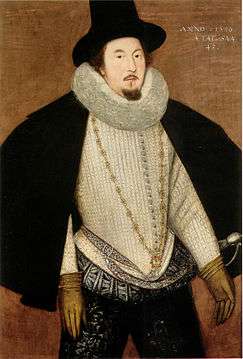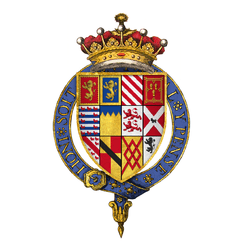Gilbert Talbot, 7th Earl of Shrewsbury
Sir Gilbert Talbot, 7th Earl of Shrewsbury, 7th Earl of Waterford, 13th Baron Talbot, KG (20 November 1552[1] – 8 May 1616) was a peer in the peerage of England.[2] He also held the subsidiary titles of 16th Baron Strange of Blackmere and 12th Baron Furnivall.


Life
He was the eldest surviving son of George Talbot, 6th Earl of Shrewsbury, by the latter's first marriage to Gertrude Manners, daughter of the first Earl of Rutland.
In 1568, Gilbert was married to Mary Cavendish, daughter of his new stepmother, Bess of Hardwick; Mary had inherited much of her formidable mother's strength of character. When Bess and her husband fell out, Gilbert took the side of his wife and his mother-in-law against his own father. However, when the old earl died in 1590, Gilbert refused Bess the widow's portion that was her due, and consequently they fell out. He appears to have been a highly quarrelsome individual, feuding with not only his stepmother but his brother and other family members, his tenants, and even Elizabeth I herself. He was overshadowed by his formidable wife: Francis Bacon remarked that she was undoubtedly "greater than he".
The children from his marriage to Mary Cavendish were:
- Lady Mary Talbot (1580–1649)
- Lady Elizabeth Talbot (1582–1651)
- Lady Alethea Talbot (1585–1654)
Two sons, George and John, died in infancy.
He was elected knight of the shire (MP) for Derbyshire in 1572. He was summoned to the House of Lords as Baron Talbot in 1589 and became 7th Earl of Shrewsbury on his father's death in 1590.[3]
In 1592, he was created a Knight of the Garter, but feuded with his former friend John Stanhope when John's brother got the post of Earl Marshal of England, which Gilbert had assumed would be his. Gilbert's stepbrother Charles Cavendish challenged Stanhope to a duel for his sake, which was not fought. Elizabeth I was displeased and took Stanhope's side.[4] After this Gilbert challenged his own brother Edward to a duel over a lease, but Edward refused to fight him. Gilbert accused his brother of planning to poison him, but lost his case against him.
Shrewsbury employed a clockmaker, Michael Neuwers to make striking clocks in 1599.[5] He became a patron of the arts, as was his daughter Alethea, who became Countess of Arundel by her marriage to Thomas Howard in 1606. Talbot's second daughter, Elizabeth, married Henry Grey, 8th Earl of Kent. The eldest, Mary, married William Herbert, 3rd Earl of Pembroke. As well as bringing up their three daughters, Gilbert and Mary Talbot spent a good deal of time with their orphaned niece, Arbella Stuart. The downfall of Arbella, who as the closest relative of King James I of England had greatly offended him by marrying without his consent, had serious consequences for Gilbert and Mary: Mary, who had aided the marriage, went to the Tower of London as a result, and Gilbert lost his seat on the Privy Council.
In the absence of a male heir, he was succeeded in the earldom of Shrewsbury by his younger brother, Edward. However, some of the extensive estates passed then (or after Edward's death) to his daughters.
Notes
- "Person Page". www.thepeerage.com.
- . Dictionary of National Biography. London: Smith, Elder & Co. 1885–1900.
- "History of Parliament". History of Parliament trust. Retrieved 10 November 2011.
- Lovell, Mary S. (2005). Bess of Hardwick, First Lady of Chatsworth. Little, Brown. pp. 398–402. ISBN 0-349-11589-3
- HMC 6th Report: Frank (London, 1877), p. 449.
External links
| Political offices | ||
|---|---|---|
| Preceded by The 6th Earl of Shrewsbury |
Lord High Steward of Ireland 1590–1616 |
Succeeded by The 8th Earl of Shrewsbury |
| Lord Lieutenant of Derbyshire 1590–1616 |
Vacant Title next held by The Earl of DevonshireLord Cavendish of Hardwick | |
| Peerage of England | ||
| Preceded by George Talbot |
Earl of Shrewsbury 1590–1616 |
Succeeded by Edward Talbot |
| Baron Talbot (writ in acceleration) 1589–1616 |
In abeyance Title next held by Alethea Howardas sole heiress | |
| Baron Furnivall 1590–1616 | ||
| Baron Strange of Blackmere 1590–1616 | ||
| Peerage of Ireland | ||
| Preceded by George Talbot |
Earl of Waterford 1590–1616 |
Succeeded by Edward Talbot |